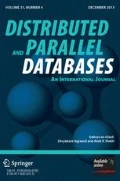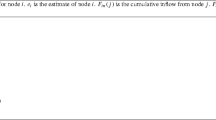Abstract
This paper describes a new algorithm for solving the distributed aggregation problem in which individual values from N nodes have to be aggregated in an associative and commutative manner, and the final result must be either computed at all sites or communicated to them. Our algorithm has a message-delay product of Θ(dN(N\(\Theta (dN(N^{\frac{1}{d}} ))\))) where N is the number of nodes, and d is a parameter that corresponds to the number of dimensions of the hypercube into which the nodes are logically organized. This reflects an improvement upon existing algorithms by a factor of d. The algorithm can be initiated by any node, and works by creating multiple parallel streams that collect partial aggregates and finally converge at a node to compute the final result.
Similar content being viewed by others
References
A. Albert and R. Sandler, An Introduction to Finite Projective Planes, Holt, Rinehart and Winston, 1968.
D. Barbara and H. Garcia-Molina, “The Demarcation protocol: A technique for maintaining arithmetic constraints in distributed database systems,” EDBT Conference, Vienna, 1992.
F. Chung, “Diameters of communications networks,” in AMS Short Course on Mathematics of Information Processing, American Mathematical Society, 1984.
D. Dolev, et al., “An O(n log n) unidirectional distributed algorithm for extrema finding in a circle,” J. Algorithms, vol. 3, pp. 245-260, 1982.
C. Hsieh, “Decentralized evaluation of associative and commutative functions,” IEEE International conference on Distributed Computing, Newport Beach, CA, 1989.
A. Kumar and M. Stonebraker, “Semantics based transaction management techniques for replicated data,” ACM SIGMOD Conference, Chicago, IL, June 1988.
T.V. Lakshman and A.K. Agrawala, “Efficient decentralized consensus protocols,” IEEE Transactions on Software Engineering, vol. SE-12,no. 5, pp. 600-607, May 1986.
T.V. Lakshman and V. Wei, “Distributed computing on regular networks with anonymous nodes,” IEEE Transactions on Computers, vol. 43,no. 2, pp. 211-218, February 1994.
M. Maekawa, “A \(\sqrt N \) Algorithm for Mutual Exclusion in Decentralized Systems,” ACM Transactions on Computer Systems, vol. 3,no. 2, pp. 145-159, May 1985.
G. Peterson, “An O(n log n) unidirectional algorithm for the circular extrema finding problems,” ACM TOPLAS, vol. 4,no. 4, pp. 758-762, 1982.
D. Skeen, “Non Blocking Commit Protocols,” ACM SIGMOD Conference, 1981, pp. 133-142.
D. Skeen and M. Stonebraker, “A Formal Model for Crash Recovery in a Distributed System,” IEEE Transactions on Software Engineering, vol. SE-9, pp. 219-228, May 1983.
Author information
Authors and Affiliations
Rights and permissions
About this article
Cite this article
Kumar, A. A New Algorithm for the Decentralized Aggregation Problem. Distributed and Parallel Databases 7, 415–427 (1999). https://doi.org/10.1023/A:1026483919295
Issue Date:
DOI: https://doi.org/10.1023/A:1026483919295




